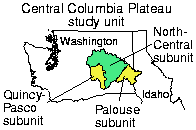
Nitrate concentrations in about 20 percent of all wells exceed the drinking water standard, which is the U.S. Environmental Protection Agency maximum contaminant level (MCL). The highest exceedance rates occur where fertilizer use and irrigation are greatest.
The primary source of nitrate in ground water is agricultural fertilizers. Other sources include cattle feedlots, food processing plants, septic tanks, and wastewater discharges.
Nitrate concentrations are generally highest in shallow wells in irrigated areas, including many domestic wells and shallow public supply wells.
Nitrate concentrations in shallow wells are among the highest in the Nation (p. 22).
Pesticides were detected in 60 percent of shallow wells and 46 percent of deeper public supply wells.
Concentrations of only three pesticides exceed the MCL or a health advisory: dieldrin, EDB, and 1,2-dichloropropane. These pesticides have been discontinued from use, and the exceedances occur in only 2 percent of the wells.
Herbicides were detected most often, especially atrazine and its breakdown products. However, no concentrations of an herbicide exceed MCLs or health advisories.
Shallow wells in irrigated agricultural areas of the Quincy-Pasco subunit have the most pesticide detections and the largest number of different pesticides detected per well. Pesticide detections also correlate with elevated nitrate concentrations.
In the Palouse subunit, none of the commonly used pesticides were detected in ground water, although 10 were detected in surface water.
Sixty-four percent of public supply wells with detections of pesticides contain more than one detectable pesticide. The human health significance of very low concentrations of several pesticides is uncertain because drinking water standards do not exist for 40 percent of the pesticides detected or for occurrences of multiple pesticides.
Pesticides were detected more frequently than the national average, with the exception of those in shallow ground water associated with dryland farming (p. 22).
However, as a result of fertilizer use leveling off since 1985, nitrate concentrations may be beginning to level off in some areas. In many areas, concentrations continue to rise.
The newer pesticides, which are less persistent in the environment than the discontinued ones, were not detected at concentrations above MCLs or health advisories. EDB, discontinued in the late 1970s, was detected more frequently in deeper wells, possibly indicating that it is moving down into deeper ground water. This is another indication that ground-water quality improvements take decades or longer.
Concentrations of nitrate and pesticides are generally similar in shallow ground water and in surface water at base flow, which occurs in winter. Trends in pesticides in ground water are most cost effectively monitored by sampling surface water at base flow, though sampling very shallow wells gives the most current picture of ground-water quality (p. 13).
Eutrophication results in excessive plant growth, sometimes reducing dissolved oxygen below levels that some fish species require.
Improving the health of aquatic ecosystems may require reducing nitrate concentrations in ground water. At one site in the Quincy-Pasco subunit, over 60 percent of the nitrogen comes from ground water (p. 13).
In most streams, sediment loading has reduced instream habitat needed by fish and other aquatic life (p. 19). Moreover, eroded soil particles carry pesticides that accumulate in streambeds and also in fish tissue.
Concentrations of some long-banned but persistent organochlorine pesticides (such as DDT) or total PCBs exceed environmental guidelines for streambed sediment at 22 percent of the sites sampled.
However, concentrations of trace elements are not elevated above naturally occurring levels in soils.
Loss of riparian habitat causes stream temperatures to increase and stream banks to become more unstable, and thus more likely to erode. Increased temperatures and sediment in streams can alter resident fish communities.
Grazing practices also contribute to erosion of destabilized stream banks.
Highest concentrations and exceedances of freshwater-chronic criteria generally occur within a month or two of pesticide application.
Most exceedances of freshwater-chronic criteria are for currently used organophosphate insecticides.
Carp in a small lake in the Quincy-Pasco subunit showed nervous system abnormalities, possibly indicating exposure to organophosphate insecticides; long-term effects are uncertain (p. 19).
Changing from furrow to sprinkler irrigation is reducing the loss of soil from irrigated cropland in the Quincy- Pasco subunit.
Soil erosion from irrigated cropland and DDT concentrations in sediment and fish correlate with the percentage of furrow-irrigated land, so changing to sprinklers also improves sediment quality.
Improved farming practices may have reduced soil erosion from dry-farmed cropland in the Palouse subunit.